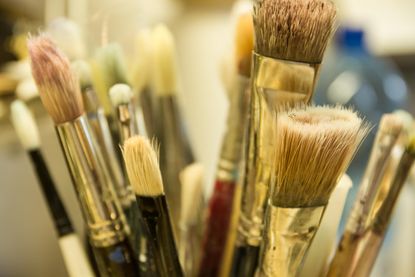How to clean paint brushes – tricks to keep them in top condition
Find out how to clean paint brushes so they’re ready for the next room refresh


Wondering how to clean paint brushes correctly? Following the right procedure means they’ll stay in great condition and will last longer, plus they’ll be ready for use the next time you need them.
Proper cleaning also ensures you can achieve professional results every time you paint a room. If paint brushes aren’t cleaned thoroughly, a poor finish next time you use them could be the result.
Our guide has the lowdown on cleaning paint brushes whichever type of paint you’ve used for each part of the room.
How to clean paint brushes
After painting a wall, ceiling, or woodwork, follow the lead of the pros and care for the brushes you’ve used straightaway. What you need to do this will depend on the type of paint finishes used, as different solvents are required for different paint types.
‘Before you start cleaning a paint brush, remove as much paint as you can from the bristles,’ says Lucy Searle, global editor in chief of Homes & Gardens. ‘Touch-up a wall as necessary, and if any paint remains on the brush after that, paint onto newspaper to remove it.’
This is how to clean paint brushes.
How to clean paint brushes after using latex paint
Cleaning paint brushes used to apply latex (water-based) paint is easy. Warm water and a mild dish soap can be used as a solvent.
Make up the solution in a small bucket or other clean container and dip the bristles of the brush into it. Use the side of the container to work the solution through the bristles, and use your fingers, too.
‘A special comb can make the job simpler,’ says Lucy. ‘It will help clean in the middle of the bristles and near to the handle, which can be awkward areas to work into. It can also be used to straighten the bristles after cleaning.’ We like the Warner Paint Brush and Roller Cover Cleaner from Amazon.
After working the paint out of the bristles, rinse in clean water. Bristles not completely clean? Repeat the procedure of washing in a dish soap solution and then rinsing.
How to clean paint brushes after using oil-based paint
For oil-based paint, you’ll need mineral spirits or turpentine as a cleaning solvent. Put this into a small bucket or other clean container and dip the brush in. Work the solvent through the bristles thoroughly, following the same method as for cleaning a paint brush after using latex paint.
Remove excess thinner by spinning the handle of the brush between your hands, then repeat the process using a clean container and fresh thinner.
How to care for brushes after cleaning them
Paint brushes should be dry before storage. While it’s possible to use a clean rag or paper towels to dry the bristles, you can help give brushes have a longer life by using a spinner after cleaning to remove excess water – we like the Purdy Brush and Roller Spinner at Amazon.
Hang paint brushes to store them, if possible. ‘Never store brushes with the bristles pressed against a surface as this can leave them curled,’ says Lucy. ‘If they aren’t hung, store them horizontally.’
What happens if you don’t wash your paint brushes?
If you don’t wash your paint brushes, paint will dry there, damaging the bristles of the brushes and reducing their lifespans. Old paint left in the bristles of a brush could spoil the finish next time you go to use it, too.
How often should you clean your paint brushes?
Paint brushes should be cleaned at the end of very painting job – and you should do it right away. After cleaning, dry the paint brushes and then store them by hanging from the handle or laying them flat.
Sign up to the Homes & Gardens newsletter
Decor Ideas. Project Inspiration. Expert Advice. Delivered to your inbox.

Sarah is a freelance journalist and editor. Previously executive editor of Ideal Home, she’s specialized in interiors, property and gardens for over 20 years, and covers interior design, house design, gardens, and cleaning and organizing a home for H&G. She’s written for websites, including Houzz, Channel 4’s flagship website, 4Homes, and Future’s T3; national newspapers, including The Guardian; and magazines including Future’s Country Homes & Interiors, Homebuilding & Renovating, Period Living, and Style at Home, as well as House Beautiful, Good Homes, Grand Designs, Homes & Antiques, LandLove and The English Home among others. It’s no big surprise that she likes to put what she writes about into practice, and is a serial house renovator.
-
 Martha Stewart made homeware essentials beautiful – and these pieces are discounted in a rare Amazon sale
Martha Stewart made homeware essentials beautiful – and these pieces are discounted in a rare Amazon sale'The most beautiful things are simple and functional but not always easy to find' – or at least they weren't before Stewart made the process simple
By Megan Slack Published
-
 This jewel box Manhattan apartment is a collage of patterns inspired by antique fabrics
This jewel box Manhattan apartment is a collage of patterns inspired by antique fabricsThe Manhattan pied-à-terre of textile collector Jill Lasersohn has been transformed with the skillful use of standout fabrics and papers from her collaboration with Schumacher
By Juliet Benning Published
-
 7 dorm room organizing rules for less clutter and more space
7 dorm room organizing rules for less clutter and more spaceExperts offer their top tips for creating a well-organized dorm room, no matter the size, space, or layout.
By Ashley Chalmers Published
-
 How to maximize storage in a small or shared dorm room, according to pro organizers
How to maximize storage in a small or shared dorm room, according to pro organizersFind out all the hidden storage zones you might never have noticed
By Ashley Chalmers Published